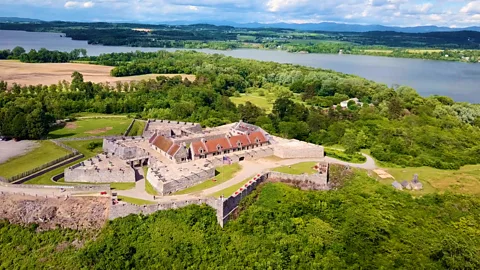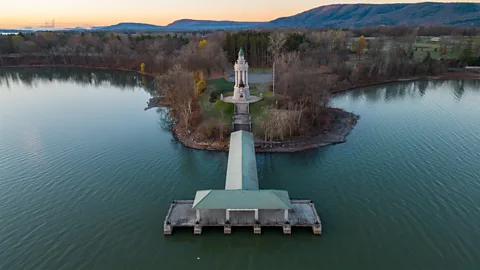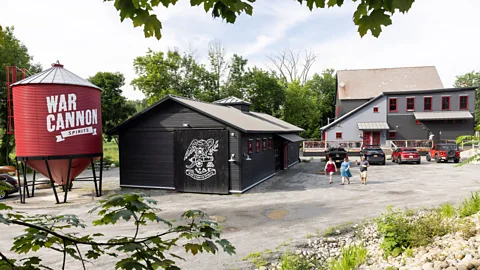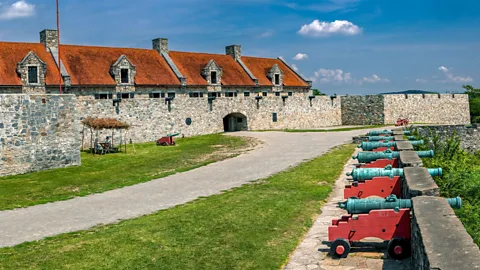The New York region that changed history 250 years ago
 Cody Updike
Cody UpdikeA surprise dead-of-night attack helped lead to US independence from the British. Now, a series of events are commemorating the region's pivotal role in shaping the nascent nation.
In the violet-grey twilight before dawn in May 1775, a skeleton crew of soldiers were asleep inside Fort Ticonderoga, a British-held garrison on the banks of Lake Champlain in New York's Adirondack region, when a series of shouts rang out. Rushing to their posts, the men were stunned by the sight of six dozen American soldiers streaming over the fort's walls, flintlock rifles in hand, demanding surrender.
With the British outnumbered and taken off guard, American victory was swift and bloodless. The fort's commander, sergeants, gunners and artillerymen were imprisoned and the invading forces captured 100 cannons and valuable weapons for the Continental Army. The surprise attack was a pivotal moment in the lead-up to the American War of Independence and marked the Continental forces' first offensive victory of the war that led to the United States' founding in 1776.
This year, to commemorate the 250th anniversary of the conflict that shaped the nation, Fort Ticonderoga is hosting a series of new museum exhibits alongside its regular lineup of historical reenactments, guided tours and boat cruises – all of which provides travellers with a great jumping-off point to explore a region replete in Revolutionary War history.
 Brooke O'Neil
Brooke O'NeilLake Champlain is a vast expanse that extends for roughly 435 square miles, straddling the borders of western Vermont and eastern New York and spilling into the Richelieu and St Lawrence rivers, which stretch north to Montreal and Quebec City in Canada. As Fort Ticonderoga curator Matthew Keagle told me, this made the waterway and its most prominent garrisons – Fort Ticonderoga and Crown Point, located 10 miles south – key locations for the movement of British troops, supplies and intelligence during the colonial period (roughly 1600 through 1776).
Emboldened by the Massachusetts militiamen who defended the towns of Lexington and Concord against British forces and initiated the war a month earlier in April 1775, two of the US's more colourful Revolutionary War figures turned north-west towards Lake Champlain. Ethan Allen, leader of the scrappy Green Mountain Boys militia, and Benedict Arnold, an ambitious, impetuous merchant whose name would later become synonymous with treachery, reluctantly agreed to share command of a dead-of-night attack on Ticonderoga.
"What was effectively a defensive war against the British… now turns into something very different," said Keagle, smartly dressed in a royal blue coat and knee-high boots, not unlike those depicted in the famous painting Capture of Fort Ticonderoga, which the historian stood in front of. "It dramatically changes the scope of the conflict."
The weapons captured at the fort were hauled 300 miles by oxen and ice sledge to Boston, where Patriots used them to batter, and ultimately expel, British troops in March 1776.
 Alamy
AlamyToday, some of those cannons, mortars and Howitzers are among 200,000 objects displayed at Fort Ticonderoga's museum, which houses the western hemisphere's largest collection of 18th- and early 19th-Century munitions, and the US's largest assemblage of 18th-Century military uniforms. Weaponry and cultural artefacts can also be found at the newly expanded museum at Crown Point, which was also captured by the Americans in May 1775.
The experiences at the two sites diverge from there. Ticonderoga, or "Fort Ti" as locals call it, was restored to its original glory with squat, thick walls, pointed corners and a three-storey barracks building. Each year, staff launch new programming highlighting different periods of the bastion's history. This year's includes a new exhibit showcasing the US's nascent national identity, reenactments exploring everything from Arnold's surprising command to the science of defence and a demonstration showing how soldiers would have rowed fleet ships to and from Fort Ticonderoga.
"We constantly have to reevaluate how we understand the past," said Keagle, of the fort's frequently changing educational events. "We want to bring visitors into the discussion, whether that's through our more specialised programmes like seminars and lectures, or by walking our trails and visiting our garden to see how people lived in this period of history."
By contrast, Crown Point is an elegiac ruin, the remnants of its 18th-Century military architecture reaching skyward from the fields. A series of well-marked trails loop around the historical site and ring the shoreline, including one that connects to the North Country Scenic Trail, which crosses eight northern US states. Because the site lies along the Atlantic Flyway, depending on the time of year, you might hear the effervescent chatter of bobolinks (which arrive in late April) , see raptors winging overhead and waterfowl gliding across the lake. Since 1976, Crown Point's bird-banding station has recorded more than 126,000 birds across 110 species.
 Cody Updike
Cody UpdikeThe Crown Point site is also a photographer favourite, both for its bird sightings and frozen-in-time features like a pair of abandoned limestone barracks and historical graffiti carved into the stones. "We're preserving the ruins of structures and the archaeological record beneath the surface," explained site manager Sam Huntington.
Around the region, a number of hikes offer panoramic views of both the inimitable Adirondack landscape and its Revolutionary landmarks.
At Coot Hill Trail, a hike known mainly to locals located about 10 miles away from Crown Point in the town of Moriah, New York, I met Arin Burdo, executive director of Champlain Area Trails (CAT). Our boots crunched through a late crust of snow along the moderately challenging 1.1-mile path to the 1,100-ft summit of Bulwagga Mountain.
"The 46 High Peaks [the highest peaks in the region] get all the attention in the Adirondacks," Burdo told me. "Many of these lower-elevation hikes have big payoffs, and features like historic cemeteries or great birding, without the crowds."
 Cody Updike
Cody UpdikeAs the trees parted around the summit, a blanket of farms and meadows spread out below. Peregrine falcons rode air currents arcing over the cliffs, set against the distant backdrop of the Green Mountains of Vermont. To the north, the ghostly barracks of Crown Point stood out along Lake Champlain's shore.
The region holds plenty of interest beyond its Revolutionary past. Fishing and boating are popular in this part of the 400,000-acre Champlain-Adirondack Unesco Biosphere Reserve, but outdoor guide Elizabeth Lee encourages terrestrial exploration, especially on CAT's 100 miles of trails. Here you may find bobcats and white-tail deer, and fancifully named plants such as scaly shagbark hickory and Dutchman's breeches, their flowers like tiny white pantaloons suspended upside-down on a clothesline.
"The CAT trails definitely give a slice of life over time," Lee said, pointing to features that date from the colonial through the Revolutionary period and beyond. "Some have remnants of quarries, mining, farming, forestry, which takes you through the early 1900s. And there's a lot of really fun architecture [that shows] the changes in American society in those towns."
Case in point: Defiance Hall by War Cannon Spirits, a distillery opened in 2022. In its cavernous, circa-1820 sawmill building, five miles from the Crown Point Historic Site, a stone alcove behind the long wooden bar was lined with whiskey, rye and vodka. I sipped a Cannonball Old Fashioned, made with whiskey, bitters, maple syrup and ginger, and wondered who used the centuries-old forest behind me to slip between strategic locations.
 Alamy
AlamyOn any given day in the hamlet of Elizabethtown, New York, originally settled by Revolutionary War veterans, you'll find a few dozen of the town's 1,000 residents, plus visitors like me, gathered at the Deer's Head Inn. Opened 1808 and used as a hospital during the War of 1812, it's now a hotel and restaurant featuring local, sustainably produced foods that nod to the cuisine of the Revolutionary past: potted lamb served with toast and curry sauce, dry-cured meats, pickled vegetables and a pear and apple crumble atop a rustic pie crust.
Night had fallen by the time I stopped in the town of Schroon, New York, founded just after the Revolution on a 141-sq-mile lake of the same name. Moonlight glimmered on the glassy water, diffusing pinpricks of yellow light from the hilltop cabins of the Lodge at Schroon Lake, which opened in 2023 on the grounds of a former religious compound. Like many places within the Adirondacks, the reminders of the US's founding here are both visible and elusive – preserved in ruins, reimagined in modern-day interpretations and reconstructions, and alive in our collective memory.
--
If you liked this story, sign up for The Essential List newsletter – a handpicked selection of features, videos and can't-miss news, delivered to your inbox twice a week.
